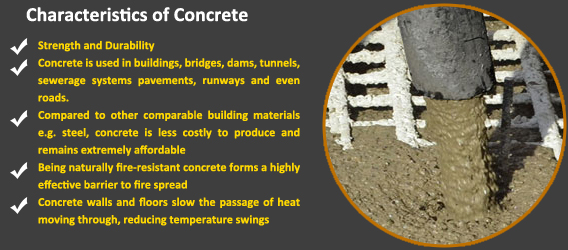Concrete is a fluid mixture of cement, aggregates, and water which can be formed into different shapes and cures to a hard and durable construction material. Masonry is construction of natural building stone or manufactured units such as brick or concrete block.
All building materials expand and contract. Concrete and other cement based products shrink permanently, and clay products expand permanently with changes in moisture content. Both materials (as well as wood, metal, glass, and plastics) expand and contract reversibly with changes in temperature. Since concrete and masonry are brittle, if construction does not accommodate this expansion and contraction, cracking and water penetration can result. Flexible anchorage and the installation of control joints in concrete and concrete masonry and expansion joints in clay masonry allow this natural expansion and contraction to occur without damage to the construction.
Concrete can be used as a structural and a finish material in slabs, walls, paving, and retaining walls. Masonry can be used as a structural system, as a veneer, or as a paving system and can be used to build fire places and retaining walls. Concrete and masonry are strong in compression but require the incorporation of reinforcing steel to resist tensile and bending stresses. Masonry veneers can be constructed over many types of structural frames and backing walls. Concrete and masonry also provide fire resistance, energy efficiency, and durability.
Fire Resistance: Concrete and masonry are noncombustible —they will not burn. This is a higher level of protection than mere fire resistance. Wood can be injected with chemicals to make it resistant to fire damage for a longer period of time than untreated wood, but ultimately wood becomes fuel for the fire. Steel is noncombustible, but it softens and bends when subjected to the high heat of a fire. In commercial construction, steel structural members must be protected from fire by sprayed on mineral coatings, layers of gypsum board, plaster, or masonry. The highest level of protection and the highest fire protection ratings are associated with concrete and masonry.
Durability: Concrete and masonry are durable against wear and abrasion and weather well for many years with little or no maintenance. Wood is highly susceptible to moisture damage and requires protective coatings to prolong service life. Properly designed and constructed concrete and masonry will provide many years of service to the home owner without any additional investment of time or money.
Energy Efficiency: For centuries the thermal performance characteristics of masonry have been effectively used in buildings. Large masonry fireplaces used during the day for heating and cooking were centrally located within a structure. At night, the heat stored in the masonry radiated warmth until dawn. In the desert South west of the United States, thick adobe masonry walls provided thermal stability. Buildings remained cool during the hot summer days, and heat stored in the walls was later radiated outward to the cooler night air. Until recently, however, there was no simple way of calculating this behavior.

